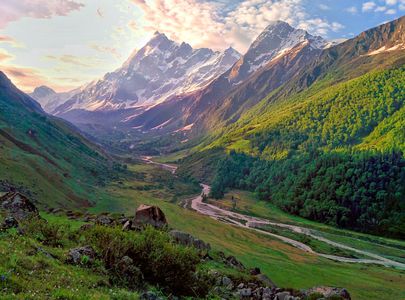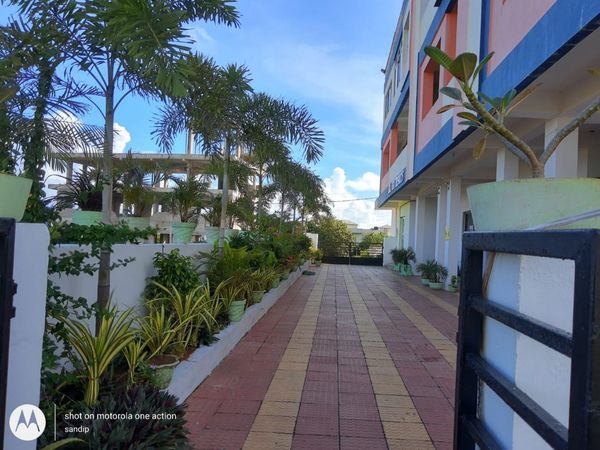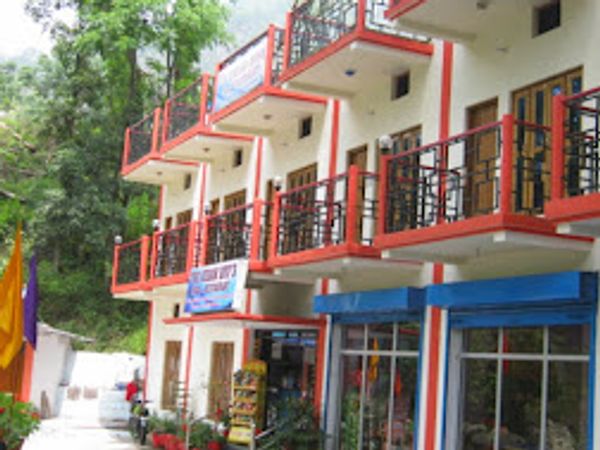Har Ki Dun Trekking Tale: Camping Amidst Snow-Capped Silence
 Palakshi Meharwal
07 Apr, 2025
10 mins read
382
Palakshi Meharwal
07 Apr, 2025
10 mins read
382

Nestled in the remote valleys of the Garhwal Himalayas, the Har Ki Dun trek is a timeless journey into the cradle of Indian mythology and alpine serenity. A perfect blend of adventure and tranquility, this trail leads travelers through ancient forests, quaint Himalayan villages, and finally into the heart of a snow-draped valley that seems untouched by time. For those yearning to escape the rush of modern life, this trek offers not just a physical challenge, but a deep emotional and spiritual connection with nature.
A Glimpse into Har Ki Dun
Har Ki Dun, meaning "Valley of Gods," is situated at an elevation of around 11,700 feet (3,566 meters) in Uttarkashi district, Uttarakhand. The trail runs along the Supin River and weaves through dense pine forests, terraced fields, and traditional wooden houses that reflect the rich cultural heritage of the region. With the Swargarohini peaks towering above, trekkers are treated to snow-covered vistas that leave a lasting impression.
Unlike the crowded tourist trails of Himachal or Ladakh, Har Ki Dun remains relatively less explored, offering solitude and authenticity. Its ancient charm is echoed in the stories shared by locals—tales of the Pandavas ascending to heaven through these very mountains, adding a mythical dimension to your journey.
Best Time to Trek: Finding the Right Season
Timing is crucial when planning your Har Ki Dun adventure. While the trail is accessible during multiple seasons, each brings its own flavor:
- Spring (April to June): This is the most popular time to trek. Rhododendrons bloom vibrantly, and the meadows are a carpet of green. Melting snow adds drama to the waterfalls, and the skies remain clear for panoramic views.
- Autumn (September to November): For those who prefer crisp air and golden-hued landscapes, post-monsoon months offer stunning clarity. The visibility of the Swargarohini range is at its best, and trails are less crowded.
- Winter (December to March): A snow-lover’s paradise. This is when Har Ki Dun transforms into a white wonderland. Camping in the snow is a surreal experience, though the trail becomes more challenging and requires proper preparation and gear.
Trekking Itinerary: Step into the Wild
A typical Har Ki Dun trek spans over 7–8 days, starting from Sankri—a small village that serves as the base camp. Here's a brief overview of the journey:
Day 1: Dehradun to Sankri
The drive from Dehradun to Sankri (around 200 km) offers glimpses of the Yamuna and Tons rivers, forested slopes, and small hill towns.
Day 2: Sankri to Taluka to Seema/Osla
A bumpy jeep ride takes you to Taluka, where the real trek begins. The 12 km trail to Osla (or nearby Seema) is filled with bird calls, stream crossings, and views of distant snow peaks.
Day 3: Osla to Har Ki Dun
As you ascend towards the valley, the landscape begins to open up. Wooden bridges, alpine flowers, and the constant sound of the Supin River accompany your walk until you reach the open valley—Har Ki Dun itself.
Day 4: Explore Har Ki Dun Valley
This is a day of rest, exploration, and awe. You can hike up to Maninda Tal or just soak in the silence of the snow-capped peaks and breathe in the pristine air.
Day 5–7: Return Journey
The descent follows the same trail back to Sankri, giving you another chance to engage with local villagers and reflect on your journey.
Camping in Silence: A Soulful Experience
Camping in Har Ki Dun is unlike any other experience. Tents are pitched on snow or grassy patches depending on the season. At night, the valley descends into a profound stillness, broken only by the rustle of wind or the distant cry of a mountain fox.
Without the intrusion of electricity or mobile signals, trekkers rediscover the joy of conversations, stargazing, and simply existing in the moment. Whether you're sharing a cup of tea with fellow trekkers or journaling by torchlight, each moment becomes a cherished memory.
The silence here is not empty—it’s filled with meaning. It allows for introspection, clarity, and connection, both with the natural world and oneself.
Wildlife, Flora, and Cultural Riches
The trail winds through Govind Pashu Vihar National Park, a biodiversity hotspot. Bird watchers can spot Himalayan monals, golden eagles, and the elusive bearded vulture. If you’re lucky, you might even see signs of Himalayan black bears or musk deer.
Equally enriching are the encounters with locals in Osla and other villages. These communities maintain a harmonious lifestyle, rooted in sustainable agriculture and ancient traditions. Their wooden temples, unique architecture, and warm hospitality add another layer of richness to the journey.
Preparing for the Trek: Essentials and Tips
While the Har Ki Dun trek is considered moderate in difficulty, preparation is key. Here's a quick guide to help:
- Fitness First: Build stamina through cardio exercises, walking, and light strength training. Acclimatization is crucial at high altitudes.
Packing List:
- Layered clothing for unpredictable temperatures
- Waterproof shoes and gaiters
- Sleeping bag rated for sub-zero nights
- First-aid kit and personal medication
- Headlamp, trekking poles, and a reusable water bottle
- Permits & Guides: Since the trail passes through protected zones, permits are mandatory. Trekking with a certified guide or through a reputable tour operator is highly recommended.
A Sustainable Adventure
Travelers to Har Ki Dun are urged to respect the fragile ecosystem. Simple actions like carrying back your waste, avoiding plastic, and staying on marked trails make a significant difference. Supporting local homestays and buying local crafts also contributes to the region’s economy.
Final Thoughts: More Than Just a Trek
Har Ki Dun is not just a trekking destination—it’s a passage into a quieter, more meaningful way of life. It teaches patience, appreciation for simplicity, and the joy of disconnecting from noise, both external and internal. The stillness of the snow-capped valley lingers long after the trek is over, calling you back to a place where time slows and nature speaks.
Written By:
Palakshi Meharwal



Hotels at your convenience
Now choose your stay according to your preference. From finding a place for your dream destination or a mere weekend getaway to business accommodations or brief stay, we have got you covered. Explore hotels as per your mood.





